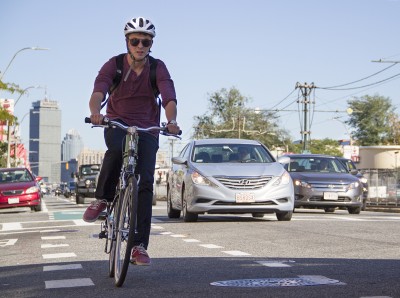
Massachusetts Gov. Charlie Baker and the Massachusetts Department of Transportation announced Monday the launch of a $12.5-million program aimed at making the streets of the commonwealth safer.
The program is called the Complete Streets Funding Program and will focus on helping cities and towns around the commonwealth make their street networks safer for all users. The $12.5 million will be used for technical assistance and construction, as well as training sessions for municipal employees.
Jacquelyn Goddard, spokesperson for MassDOT, said the funding program will be helpful for ensuring the safety of not only pedestrians, but also cyclists and drivers.
“The program is intended to make streets and pedestrian pathways safer in all our communities statewide, throughout Massachusetts,” Goddard said. “We want to provide money so communities can find ways to make infrastructure improvements, so that the roads are safer for drivers, so that sidewalks are safer for all … This money will go a long way in helping cities and towns make those improvements.”
Goddard said the Complete Streets Program is open to cities and towns that feel the need to improve their infrastructures, but applicants will be required to undergo training so they know how to use the funds properly.
“As part of applying, we require the city and town officials to do a very small, short training program so that they understand how the money can be used,” Goddard said. “We want to walk them through the application process so that they will be successful. Even the most sophisticated community that has been involved in planning and design for more safety may pick up some advice … so it’s a worthwhile exercise for them to go through.”
Goddard also said the program is about modernization and renewing infrastructures that were created a long time ago.
“The population of [Massachusetts] communities has increased since towns were founded, and the modes of transportation have evolved,” Goddard said. “Very often, towns and cities have not thought proactively in terms of how to better design their streetscape for safety issues, and this money will go a long way to assisting leaders of different communities to implement designs to make their communities safer.”
Baker said in a Monday press release that his administration is committed to making transportation easier and safer in cities and towns.
“We are proud to offer communities this opportunity to improve the accessibility of neighborhoods, retail areas, and city and town centers, ” Baker said in the release. ” … Complete Streets designs encourage more environmentally friendly ways of travel, support safe pathways for commuters and the traveling public, and allow each community to approach their own unique and specific needs.”
Several Boston residents said they support the initiative and that the City of Boston could use some help in building safer streets.
Mario Daoud, 43, of Back Bay, said in comparison to other cities, Boston has work to do, especially in terms of maintenance and building newer infrastructures.
“I lived more than 10 years in Dubai,” he said. “It’s a new city, everything is perfect — the buildings, the roads. I also visited many cities in Europe, and each of them is better than Boston. So I think it’s great that they’re trying to improve the quality of the streets.”
Ken Hall, 25, of Fenway, said combining financial investment with technological improvements could only be beneficial to Massachusetts.
“Massachusetts is already starting to do driver-identified potholes,” he said. “With the connected car and things like that, they will be able to build a network that’s better organized as the cars progress. So if money goes to supporting that, from a functional stand point, that would improve the streets and the traffic.”
Beth Bechard, 39, of Allston, said both walking and driving in Boston are dangerous and require precautions.
“There’s a difference between ‘safe’ in terms of the pedestrian and ‘safe’ in terms of the driver,” she said. “Walking is safe. Of course, you always have to be aware. Driving is less safe because the infrastructure has not kept up with the demand of the vehicles. It’s also not user-friendly or safe for bikers.”






















































































































